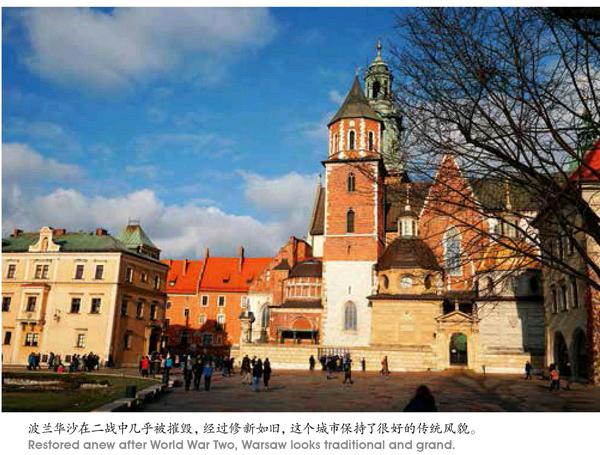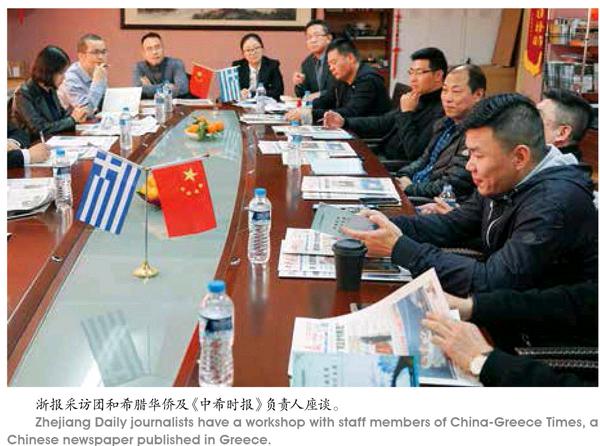携手讲好丝路故事
肖国强
2000多年前,一条打通东西方的古丝绸之路,打开了各国友好交往的新窗口,书写了人类发展进步的新篇章。
2000多年后的今天,习近平主席提出的“一带一路”倡议,已经成为构建人类命运共同体的重要探索与实践。

“国之交在于民相亲,民相亲在于心相通。”日前,笔者随浙江日报报业集团采访团走进“一带一路”沿线国家波兰、捷克、希腊。
文化如水,温润人心。穿行在波兰、捷克、希腊的大街小巷,徜徉在一座座历史建筑、一处处文化遗产之中,我们深感其文明之悠久、文化之厚重,更感叹其对历史文化保护之重视。
在和三国主流媒体及有关人士的采访交流中,我们深切感受到,开展媒体合作、夯实民意基础、增进理解互信已经成为共同的心声。
留住民族文化的根脉

波兰首都华沙是一座历史悠久的文化名城,更难以想象,这座城市竟然经历了一次奇迹般的历史文化的“浴火重生”。
二战中,华沙85%以上的建筑被毁,老城内一片焦土,古建筑更是荡然无存。二战结束后,为了再现这座历史名城當年的辉煌,波兰决定按照战前测绘并完整保存下来的建筑资料重建华沙老城,同时兴建新城。经过前后约20年的重建,老城内900多座古建筑或重建或修复,昔日的宫殿、城堡和教堂再现巍峨,老城内的街道也都保留着中世纪的完美风貌。与此同时,华沙将新城区建设规划在远离古城的地区,避免了新城建筑对古城的轮廓产生影响。1980年,华沙老城作为唯一的完全重建案例,成功入选世界遗产名录。
我们行走在老城中的肖邦公园,行走在老城中依然保留着旧时风貌的居里夫人故居,没有半点违和感,有的只是发自内心的感叹,感叹于波兰人民为留住历史记忆、延续波兰文化的远见和努力。
站在捷克首都布拉格广场抬眼望去,更有一种别样的韵味:红色房顶,宛如童话;金色塔尖,梦幻迷离……也许,在这里才能更好地体味尼采当年所说“当我想以一个词来表达神秘时,我只想到了布拉格”的意蕴。
当我们谈起布拉格独特的建筑文化时,捷克《权利报》副总编辑普雷斯尼克非常自豪:“我去过中国,中国有悠久的文化,我们捷克也有。特别是我们布拉格的建筑是独一无二的,不论是哥特式、文艺复兴式还是巴洛克式的建筑,在这里都能看到。”他认真地说:“留住民族文化的根非常重要,我们布拉格在这方面做得很好。”
普雷斯尼克确实有理由自豪。近千年来,无论入侵与战争如何频繁发生,自然灾害如何凶猛异常,布拉格从来没有中断过对历史古迹的修建和维护。如今,在布拉格面积只有900公顷的城市核心区,国家级历史保护文物达2000处。
在布拉格,老城区的房子只许室内装修,不准动外部结构。如果这幢房子是文物,没有文物保护部门的许可,房子的屋顶、外墙、装饰甚至墙体颜色都不能有任何变动。

也许,原汁原味和不曾“被破坏”,这正是布拉格成为全球第一个整座城市被定为世界文化遗产的秘密吧。
冬日温暖的阳光中,我们登上了雅典卫城。这里是古代希腊人祭祀守护女神雅典娜的圣地。矗立于卫城之巅,只见那座历经风雨侵蚀、炮火轰击被称为“欧洲文明纪念碑”的帕特农神庙,如今仅剩断壁残垣,但其巍峨壮观的姿态依旧震撼人心。一旁的工人们,正在对神庙中的大理石柱进行异常“缓慢”的修复工作。
说缓慢,是因为这样的修复工作已经开展了40多年。为了保持古迹结构的完整性和真实性,希腊政府使用了最好的材料和最新的技术。到目前为止,保护和恢复工程花费已超过1亿欧元。
修了这么久,为什么不拆了重建?这正是希腊文物保护不可触碰的“红线”——“拆”是绝对禁忌。希腊独立100多年来,历届政府都不遗余力地保护文化遗产。从1834年通过第一部文化遗产保护法起,希腊在对待古迹方面的基本原则就是“文化遗迹永远是第一位的”。
为了保护好雅典卫城,希腊采取了多种措施,包括在遗址边缘确立缓冲区,严防破坏、偷窃和盗挖等。正因为有了如此严格的规定,雅典卫城在每天有近万人参观游览的情况下,依然保持着原貌,熠熠生辉。
世界关注中国倡议
“一带一路”倡议提出4年来,以其实实在在的成果,诠释了以和平合作、开放包容、互学互鉴、互利共赢为核心的丝路精神,受到全球广泛关注,也受到了我们此访3个国家媒体同行的高度评价。
波兰三大主流报纸之一《经济法律日报》副社长多米尼克认为,中波加强经贸交流非常有必要。在她看来,“一带一路”就是一条新丝绸之路,“它对波兰非常有意义,也是一条全新的贸易渠道,我本人包括所接触到的波兰民众对此都持开放态度。”她同时表示,希望两国进一步开展媒体合作,更好地介绍新丝绸之路,“让越来越多的人了解新丝绸之路,让两国的贸易往来越来越多。”
“‘一带一路是友好的、和平的倡议,我们非常乐意看到它成功。”希腊《每日新闻报》周末版主编巴巴多普罗斯对本报记者说,希腊和其他许多欧洲国家一样,都非常钦佩“一带一路”倡议,特别是中远集团收购比雷埃夫斯港口股权让希腊受益很多,也增强了希腊更快走出债务危机的信心。
共同夯实民意基础
作为捷克最有影响力的主流报纸之一,《权利报》曾在2016年3月刊登了习近平主席访问捷克前夕发表的署名文章《奏响中捷关系的时代强音》,对中国有着较深的了解。endprint

“習近平主席提出的‘一带一路倡议,是一个全新的理念,我们认为有很大的前景和影响。”《权利报》副总编辑普雷斯尼克告诉笔者,近年来,中捷越走越近、关系越来越好,这和“一带一路”倡议有直接关系。对于中国秉持共商共建共享的全球治理观,坚持国家不分大小、强弱、贫富一律平等,普雷斯尼克也印象深刻:“捷克有史以来一直深受周边大国的影响,中国能平等发展和所有国家的关系,这令我十分敬佩。”
作为《权利报》专门负责报道中国新闻的记者,茨坦尼克也坦率地对当前“一带一路”建设提出了建议。他说,当前捷克国内对于“一带一路”带来的贸易逆差还有不同看法,同时,“一带一路”目前大多是一些大企业参与,如何让捷克的中小企业也参与进来,这些都是未来需要解决的问题。
“最重要的是加深认识和了解。”普雷斯尼克说,未来,两国之间除了高层交往之外,还要扩大两国民众之间的交流,让“一带一路”走进公众,让普通民众也能共享“一带一路”发展机遇。他表示,非常愿意和浙报集团等中国媒体开展合作,介绍各自的地方特色,介绍中国包括浙江的中小企业、地方特色和文化名人,同时也把捷克的企业和文化介绍给中国,进一步增加两国人民之间的相互了解。
用“心”讲好丝路故事
在采访中,三国的媒体同行坦诚告诉我们,虽然已经有越来越多的国家和民众对“一带一路”持开放态度,但不可否认,在欧洲乃至其他地区,仍有一些国家和政党由于各种各样的原因,不理解“一带一路”。
对此,希腊《中希时报》社长吴海龙介绍,眼下他们正在做一件事情,就是在大使馆的指导下,请来希腊语专家把关,把中共十九大报告全文翻译成希腊文,在报纸上连载,其目的就是让希腊政府官员和民众能够原汁原味地从报告中了解一个更加真实的中国,了解中国推动构建人类命运共同体的美好愿望。
《中希时报》执行总编辑杨少波说,“一带一路”是经济合作之路,也是文化交流之路,我们要以文化“软实力”为“硬实力”铺路,以文化的交流交融推动各国相互理解、相互尊重、相互信任,媒体在这方面义不容辞。为此,媒体在“一带一路”报道中,要讲好丝路故事,用故事说理,用事实说话,让“一带一路”倡议更加深入人心。比如,在希腊传说中,两个拜占庭僧侣把中国的蚕卵藏在拐杖里带回希腊,古希腊语中把中国称为丝之国,发音就是“Sl”。茶叶在希腊语中也保持着汉语的发音。在国与国的交往中,如果能多讲一些生动友好的故事,有助于进一步拉近两国人民之间的距离。
媒体是联通民心的桥梁、纽带和窗口。中希工商总会常务副会长翁进东建议,“一带一路”是一项伟大的事业,我们要有足够的耐心,要考虑到沿线国家特别是西方国家的不同国情政情,进一步深化交流合作,消除隔阂,释放信任,让各国民众在心与心的交融中更好地理解“一带一路”。
More than 2,000 ago, a network of trade routes stretching from the Korean peninsula and Japan to the Mediterranean Sea brought the East and West culturally together. The camel bells rang again after 2,000 years of vicissitudes. A development strategy unveiled by Xi Jinping in 2013 to focus on connectivity and cooperation between Eurasian countries underlines China's push to take a larger role in global affairs with a win-win trading network. I recently joined a trip organized by Zhejiang Daily Press Group. The cultural immersion in Poland, the Czech Republic and Greece enhanced my understanding of the significance of the ‘Belt and Road initiative and made me reevaluate the importance of joining hands to protect the cultural treasures of human beings. Bathed in the well-conserved cultural glory of some of the worlds finest cities, one cannot help feeling the strong ‘silky bond being restored by Chinese strategists and shared by a growing number of Eurasian nations.
Warsaw, the capital and largest city of Poland, was believed to be one of the most beautiful cities in the world until World War II. Warsaw's mixture of architectural styles reflects the turbulent history of the city and country. During the Second World War, Warsaw was razed to the ground by bombing raids and planned destruction, with 85% of its buildings in ruins. Within twenty years after the war, most of the historical buildings were reconstructed. The metropolis has gained the new title of Phoenix City because of its extensive history and complete reconstruction after the severe damage it suffered in World War II. The picturesque Old Town of Warsaw, which represents examples of nearly every European architectural style and historical period, was listed as a World Heritage Site by UNESCO in 1980.endprint
Warsaw is renowned, most notably, for several dozen museums and outspread greenery, with around a quarter of the city's area occupied by parks. ?azienki Park, also rendered "Royal Baths Park", is the largest park in Warsaw. It is visited by tourists from all over Poland and the world, and serves as a venue for music, the arts, and culture. Warsaw is the proud hometown of Maria Curie, the first woman to win a Nobel Prize and the only woman to win twice.
Walking in the historic Old Town Square in Prague, the capital of the Czech Republic, I could not help feeling baptized by the unique cultural richness of the city that once enthralled Friedrich Nietzsche so much that he regarded the city as the synonym of ‘mystery.
“Prague is a treasure trove of various architectural styles represented by the Gothic Church of Our Lady before T?n and the Baroque St. Nicholas Church. “The city did a wonderful job in preserving its cultural roots,” said Deputy Editor-in-Chief of Pravo Daily.
Prague is home to a number of famous cultural attractions, many of which survived the violence and destruction of 20th-century Europe. In fact, the city has never ceased the protection of its historical monuments over the past 1,000 years. Since 1992, the citys 900-hectare extensive historic heart, which boasts as many as 2,000 cultural sites, has been included in the UNESCO list of World Heritage Sites. In the Old Town area, not a single architectural detail is allowed to be altered without permission from the local government. The result of such vigorous protection is the citys primitive beauty left untainted in modernization.
On the rocky outcrop above the city of Athens, the Acropolis of Athens is safeguarding the countrys great architectural and historic significance, the most famous of which being the Parthenon - regarded as an enduring symbol of Ancient Greece, Athenian democracy and western civilization, and one of the world's greatest cultural monuments. The Parthenon is also a paragon of cultural relic restoration – it took workers more than four decades of hard work and a capital input that has topped 100 million Euro to restore the original fa?ade and all the decorative sculptures of what is considered the finest example of Greek architecture. For the Greek government, the countrys cultural core always comes first on the agenda. Today it attracts millions of tourists every year, who travel up the path at the western end of the Acropolis, through the restored Propylaea, and up the Panathenaic Way to the Parthenon.endprint

